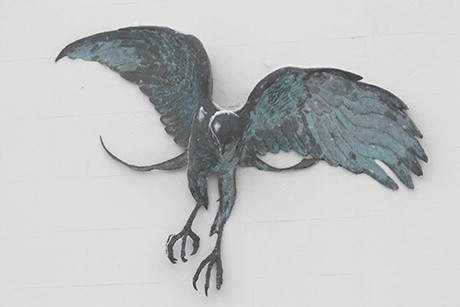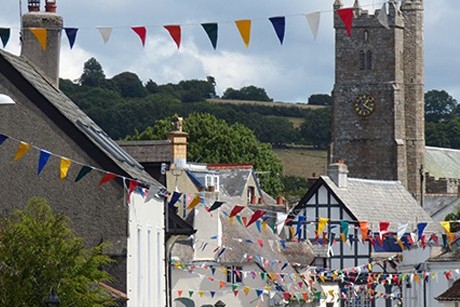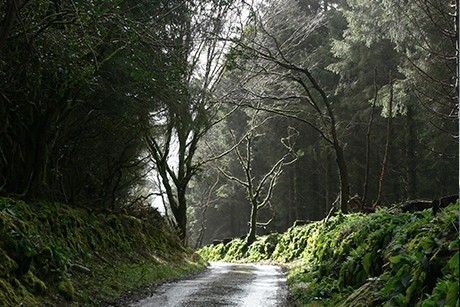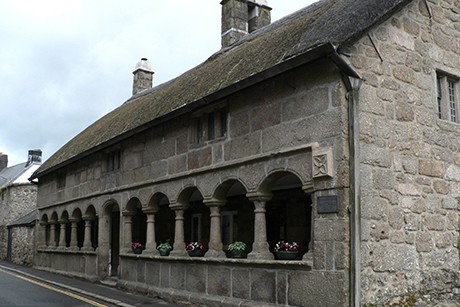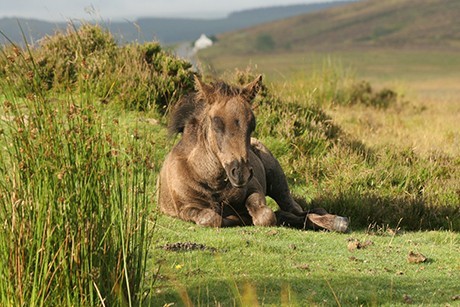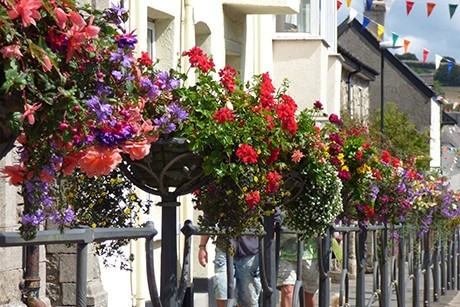Exeter Airport is five miles from the city centre with a shuttle bus into the main Exeter St. David's Railway Station.
Bristol Airport is a little further afield but easily accessible by car (approximately 2 hours). Regular rail and bus services are available to and from Exeter city centre to the airport.
www.bristolairport.co.uk
Exeter Airport is five miles from the city centre with a shuttle bus into the main Exeter St. David's Railway Station.
Bristol Airport is a little further afield but easily accessible by car (approximately 2 hours). Regular rail and bus services are available to and from Exeter city centre to the airport.
www.bristolairport.co.uk
The bus ‘terminus’ in Moretonhampstead is at Court Street Car Park, with bus stops at the top of Ford Street, Station Road and wherever you politely ask the bus driver to stop. A regular bus service runs between Exeter and Moretonhampstead via Steps Bridge (no. 359) at two hourly intervals, Monday to Saturday. The journey time is one hour.
Daily bus service
No. 359 to Exeter (no service on Sundays).
No. 178 to Okehampton.
No. 178 to Newton Abbot No. via Lustleigh and Bovey Tracey.
No. 173 and 178 to Chagford (Castle Drogo and Drewsteignton is covered by this route).
During the summer months there is an extra service to Yelverton and Plymouth via Dartmoor. Timetables are displayed at the bus stops in Station Road and Ford Street, and Court Street Car Park.
Full timetables for all local bus services are available at the Post Office, Library and Information Centre. They are re-printed every May.
The bus ‘terminus’ in Moretonhampstead is at Court Street Car Park, with bus stops at the top of Ford Street, Station Road and wherever you politely ask the bus driver to stop. A regular bus service runs between Exeter and Moretonhampstead via Steps Bridge (no. 359) at two hourly intervals, Monday to Saturday. The journey time is one hour.
Daily bus service
No. 359 to Exeter (no service on Sundays).
No. 178 to Okehampton.
No. 178 to Newton Abbot No. via Lustleigh and Bovey Tracey.
No. 173 and 178 to Chagford (Castle Drogo and Drewsteignton is covered by this route).
During the summer months there is an extra service to Yelverton and Plymouth via Dartmoor. Timetables are displayed at the bus stops in Station Road and Ford Street, and Court Street Car Park.
Full timetables for all local bus services are available at the Post Office, Library and Information Centre. They are re-printed every May.
W www.devonbustimetables.info
Moretonhampstead is easily accessible from two major trunk roads. Follow the M5 westbound to the end of the motorway at Junction 31. Continue and three miles further on the road divides into the A30 and A38.
A30: continue west following the signs to Okehampton until the Whiddon Down turnoff (approx. 20 miles). Keep left and drive up through the village, past the services and at the roundabout at the top hill turn left onto the A382 and continue south to Moretonhampstead (approx. 8 miles).
For a more scenic route go left at the first junction on the A30 signposted Exeter, Marsh Barton and M'hampstead and bear left off the bottom of the slip road. Follow the road past Ide to a 'T' Junction where you turn left and take the A3212 to Moretonhampstead (approx 12 miles).
This scenic route is steep and narrow in places and not suitable for caravans or large vehicles.
A38: follow signs for Plymouth, bearing right after approx 2 miles where dual carriage way splits to go to Torquay. Leave dual carriageway at the junction for Newton Abbot and Bovey Tracey, using the right hand lane, and follow the signs to go right to Bovey Tracey and Moretonhampstead. Go straight across the next two roundabouts, bypassing Bovey Tracey and continue straight on along the A382 northbound to Moretonhampstead (approx 12 miles).
Parking in Moretonhampstead
The town has two car parks. One in Court Street and one in Station Road. A small hourly charge is made for parking. There is some free, short term, on-road parking available. All parking is free on Sundays.
Petrol Stations
There is no petrol station in Moretonhampstead, but here is a list of the nearest to town.
Whiddon Down Services
Distance: 6 miles north
Opening hours: 24 hour service
Bovey Tracey
Distance: 8 miles south
Opening hours: 24 hour service
Dunsford
Distance: 6 miles east
Opening times: Monday - Friday 8am – 6pm / Saturday 8am - 12.00 noon
Yelverton
Distance: 20 miles over the moor
Opening times: Monday - Saturday 9am - 10pm
Moretonhampstead is easily accessible from two major trunk roads. Follow the M5 westbound to the end of the motorway at Junction 31. Continue and three miles further on the road divides into the A30 and A38.
A30: continue west following the signs to Okehampton until the Whiddon Down turnoff (approx. 20 miles). Keep left and drive up through the village, past the services and at the roundabout at the top hill turn left onto the A382 and continue south to Moretonhampstead (approx. 8 miles).
For a more scenic route go left at the first junction on the A30 signposted Exeter, Marsh Barton and M'hampstead and bear left off the bottom of the slip road. Follow the road past Ide to a 'T' Junction where you turn left and take the A3212 to Moretonhampstead (approx 12 miles).
This scenic route is steep and narrow in places and not suitable for caravans or large vehicles.
A38: follow signs for Plymouth, bearing right after approx 2 miles where dual carriage way splits to go to Torquay. Leave dual carriageway at the junction for Newton Abbot and Bovey Tracey, using the right hand lane, and follow the signs to go right to Bovey Tracey and Moretonhampstead. Go straight across the next two roundabouts, bypassing Bovey Tracey and continue straight on along the A382 northbound to Moretonhampstead (approx 12 miles).
Parking in Moretonhampstead
The town has two car parks. One in Court Street and one in Station Road. A small hourly charge is made for parking. There is some free, short term, on-road parking available. All parking is free on Sundays.
Petrol Stations
There is no petrol station in Moretonhampstead, but here is a list of the nearest to town.
Whiddon Down Services
Distance: 6 miles north
Opening hours: 24 hour service
Bovey Tracey
Distance: 8 miles south
Opening hours: 24 hour service
Dunsford
Distance: 6 miles east
Opening times: Monday - Friday 8am – 6pm / Saturday 8am - 12.00 noon
Yelverton
Distance: 20 miles over the moor
Opening times: Monday - Saturday 9am - 10pm
There are major train stations at Newton Abbot and Exeter (both 12 miles) and Plymouth (26 miles). National and regional trains run regularly to all three stations all year round.
For information about train times and services www.nationalrail.co.uk
National Rail Enquiries 03457 48 49 50
There are major train stations at Newton Abbot and Exeter (both 12 miles) and Plymouth (26 miles). National and regional trains run regularly to all three stations all year round.
For information about train times and services www.nationalrail.co.uk
National Rail Enquiries 03457 48 49 50
Mooreland Taxis (North Bovey): 01647 441143
R.S.Taxis (Chagford): 01647 2729008
Chagford Taxis (Chagford): 01647 433219
Mooreland Taxis (North Bovey): 01647 441143
R.S.Taxis (Chagford): 01647 2729008
Chagford Taxis (Chagford): 01647 433219
Today the most common association with Moretonhampstead is the moor - Dartmoor - which rises to a height of two thousand feet within sight of the town. Our forebears might have looked up to the western horizon and seen only an inhospitable line of hills from which they could extract tin, and seen nothing of beauty, but the moor has always dominated us.
Four thousand years ago Bronze Age settlers divided up the area and created the largest stone circle on Dartmoor on top of Mardon Down, just outside the present town and their Iron Age successors built substantial hill forts at Cranbrook and Wooston in the Teign Valley, part of a series circling the moor that can still be seen today. Only when the Saxons arrived about 682 AD did the area become a settlement called Moor-tun: settlement in the moor.
The Domesday Book (1086 AD) shows that the Royal Manor of ‘Moretona’, with some neighbouring manors, supported upwards of 5000 sheep. Wool and the manufacture of woollen cloth formed the basis of the town's economy for over 700 years. Most of the 1000 acres of woodland recorded here by the Normans were also maintained as a vital resource over the years - places we visit today, The National Trust and the Woodland Trust areas between Steps Bridge and Fingle Bridge on the beautiful River Teign.
In 1207 AD King John granted a weekly market that lasted until 1939 and an annual five-day fair that has now become carnival week in late August. The market ’borough’ grew steadily and was very prosperous until the end of the 17th century, when the wool industry moved north to areas with coal for steam-power. However, the town continued to be a local trading centre and a vital watering place for travellers on the difficult routes across Dartmoor from Tavistock and Plymouth to Exeter, Newton Abbot, and Crediton. Captured Napoleonic officers, some with their families and servants, were brought here from Plymouth on their word not to escape; evidence of them can be still be found such as two gravestones in the church porch. Wheeled transport grew only after the creation of turnpike roads in the 1800s and there was a single track railway line to Newton Abbot from 1866 to 1964.
Moreton has figured in two infamous murder cases. William de Tracey, the leading assassin of Archbishop Thomas Becket at Canterbury Cathedral in 1170, was possibly the lord of the manor as he gave 1500 acres around the hamlet of Doccombe in the parish, including Mardon Common, in atonement for the murder to the monks of Christchurch Canterbury; the church owned it until 1865. On the old road to Doccombe Jonathan May was murdered in 1835 and the man found guilty was sent to Australia until he was pardoned for ‘miscarriage of justice’ 40 years late
The Courtenay family of Powderham (later titled the Earls of Devon), the lords of the manor for over 600 years, added the name Hampstead about 1450, perhaps to distinguish it from other ‘Moretons’ in the country. From 1890 to 1928 the descendants of W H Smith, the stationer, owned the manor properties (about 60% of the parish), providing many fine farm and domestic buildings, the Manor House (now Bovey Castle) and a cottage hospital. The Bowring family have also been important benefactors with the gift of the Library and one of the first affordable housing estates at Kinsmansdale early last century.
Unfortunately, a series of disastrous fires destroyed many of Moretonhampstead's ancient buildings, but a sufficient number still remain. Much of the town’s centre is designated a Conservation Area, with many 'Listed Buildings' of architectural and historic interest, notably the Grade 1 Parish Church and the Almshouses on Cross St. Many have been put to new uses; the former primary school is now Greenhill Arts and Heritage Centre and the bus depot houses a motor vehicle museum. Since 1952 the whole parish of 7,500 acres has enjoyed the protection of being within the Dartmoor National Park.
Legends
With its mists, bogs and will o' the wisp, Dartmoor has always been surrounded with stories of ghosts and mysterious legends. Moretonhampstead, with its old buildings and ancient history, also has more than its share of mysteries and tales.
For more information please go to:
www.dartmoor.gov.uk/learningabout/lab-studentarea/dartmoor-legends
Today the most common association with Moretonhampstead is the moor - Dartmoor - which rises to a height of two thousand feet within sight of the town. Our forebears might have looked up to the western horizon and seen only an inhospitable line of hills from which they could extract tin, and seen nothing of beauty, but the moor has always dominated us.
Four thousand years ago Bronze Age settlers divided up the area and created the largest stone circle on Dartmoor on top of Mardon Down, just outside the present town and their Iron Age successors built substantial hill forts at Cranbrook and Wooston in the Teign Valley, part of a series circling the moor that can still be seen today. Only when the Saxons arrived about 682 AD did the area become a settlement called Moor-tun: settlement in the moor.
The Domesday Book (1086 AD) shows that the Royal Manor of ‘Moretona’, with some neighbouring manors, supported upwards of 5000 sheep. Wool and the manufacture of woollen cloth formed the basis of the town's economy for over 700 years. Most of the 1000 acres of woodland recorded here by the Normans were also maintained as a vital resource over the years - places we visit today, The National Trust and the Woodland Trust areas between Steps Bridge and Fingle Bridge on the beautiful River Teign.
In 1207 AD King John granted a weekly market that lasted until 1939 and an annual five-day fair that has now become carnival week in late August. The market ’borough’ grew steadily and was very prosperous until the end of the 17th century, when the wool industry moved north to areas with coal for steam-power. However, the town continued to be a local trading centre and a vital watering place for travellers on the difficult routes across Dartmoor from Tavistock and Plymouth to Exeter, Newton Abbot, and Crediton. Captured Napoleonic officers, some with their families and servants, were brought here from Plymouth on their word not to escape; evidence of them can be still be found such as two gravestones in the church porch. Wheeled transport grew only after the creation of turnpike roads in the 1800s and there was a single track railway line to Newton Abbot from 1866 to 1964.
Moreton has figured in two infamous murder cases. William de Tracey, the leading assassin of Archbishop Thomas Becket at Canterbury Cathedral in 1170, was possibly the lord of the manor as he gave 1500 acres around the hamlet of Doccombe in the parish, including Mardon Common, in atonement for the murder to the monks of Christchurch Canterbury; the church owned it until 1865. On the old road to Doccombe Jonathan May was murdered in 1835 and the man found guilty was sent to Australia until he was pardoned for ‘miscarriage of justice’ 40 years late
The Courtenay family of Powderham (later titled the Earls of Devon), the lords of the manor for over 600 years, added the name Hampstead about 1450, perhaps to distinguish it from other ‘Moretons’ in the country. From 1890 to 1928 the descendants of W H Smith, the stationer, owned the manor properties (about 60% of the parish), providing many fine farm and domestic buildings, the Manor House (now Bovey Castle) and a cottage hospital. The Bowring family have also been important benefactors with the gift of the Library and one of the first affordable housing estates at Kinsmansdale early last century.
Unfortunately, a series of disastrous fires destroyed many of Moretonhampstead's ancient buildings, but a sufficient number still remain. Much of the town’s centre is designated a Conservation Area, with many 'Listed Buildings' of architectural and historic interest, notably the Grade 1 Parish Church and the Almshouses on Cross St. Many have been put to new uses; the former primary school is now Greenhill Arts and Heritage Centre and the bus depot houses a motor vehicle museum. Since 1952 the whole parish of 7,500 acres has enjoyed the protection of being within the Dartmoor National Park.
Legends
With its mists, bogs and will o' the wisp, Dartmoor has always been surrounded with stories of ghosts and mysterious legends. Moretonhampstead, with its old buildings and ancient history, also has more than its share of mysteries and tales.
For more information please go to:
www.dartmoor.gov.uk/learningabout/lab-studentarea/dartmoor-legends
Bursting with useful literature and ideas the Information Centre is the first place to visit on your arrival. Its friendly staff of volunteers will give you a warm welcome, and make your introduction to Moretonhampstead a happy and enjoyable one. Most of the Information Centre staff know Devon and the Dartmoor National Park throughly. They will be pleased to share with you their knowledge of the area, help you select a walk or two, or just advise you on fun family outings and things to do.
They can also help you find local accommodation or just a good place to eat during or after your busy day.
The Information Centre is easily found, as it is situated right in the centre of the town. Although small on the outside, like an Aladdin’s cave it is full of wonders on the inside. It stocks a wide range of books, maps and guides, plus an extensive selection of free leaflets and programmes on local events and major attractions. All of which will provide you with the information you need to plan your stay and make the most of your visit.
If you are looking for something special, or want to take a little part of Devon home with you, then there is also a wide range of gifts, cards, photographs and books created by local artists and authors, ideal for mementoes, presents or celebrations.
Opening Hours
April - October 9.30am - 5.00pm seven days per week
November - March Thursday - Saturday 10.00am - 4.00pm Sunday 11.00am - 3.00pm
Bursting with useful literature and ideas the Information Centre is the first place to visit on your arrival. Its friendly staff of volunteers will give you a warm welcome, and make your introduction to Moretonhampstead a happy and enjoyable one. Most of the Information Centre staff know Devon and the Dartmoor National Park throughly. They will be pleased to share with you their knowledge of the area, help you select a walk or two, or just advise you on fun family outings and things to do.
They can also help you find local accommodation or just a good place to eat during or after your busy day.
The Information Centre is easily found, as it is situated right in the centre of the town. Although small on the outside, like an Aladdin’s cave it is full of wonders on the inside. It stocks a wide range of books, maps and guides, plus an extensive selection of free leaflets and programmes on local events and major attractions. All of which will provide you with the information you need to plan your stay and make the most of your visit.
If you are looking for something special, or want to take a little part of Devon home with you, then there is also a wide range of gifts, cards, photographs and books created by local artists and authors, ideal for mementoes, presents or celebrations.
Opening Hours
April - October 9.30am - 5.00pm seven days per week
November - March Thursday - Saturday 10.00am - 4.00pm Sunday 11.00am - 3.00pm
The Square
Moretonhampstead
Devon
TQ13 8NF
T 01647 440043
E [email protected]
Moretonhampstead Dental Surgery: 01647 440968
Moretonhampstead Health Centre: 01647 440591
Moreton Pharmacy: 01647 440234
Out of hours medical assistance (non-emergency): 111
Moorgate Vets: 01647 440441
Community Police: 111
Moretonhampstead Dental Surgery: 01647 440968
Moretonhampstead Health Centre: 01647 440591
Moreton Pharmacy: 01647 440234
Out of hours medical assistance (non-emergency): 111
Moorgate Vets: 01647 440441
Community Police: 111
Moretonhampstead at-a-glance
